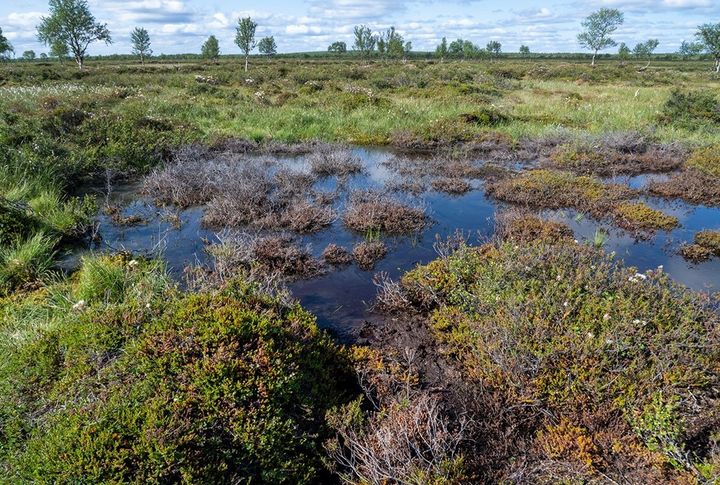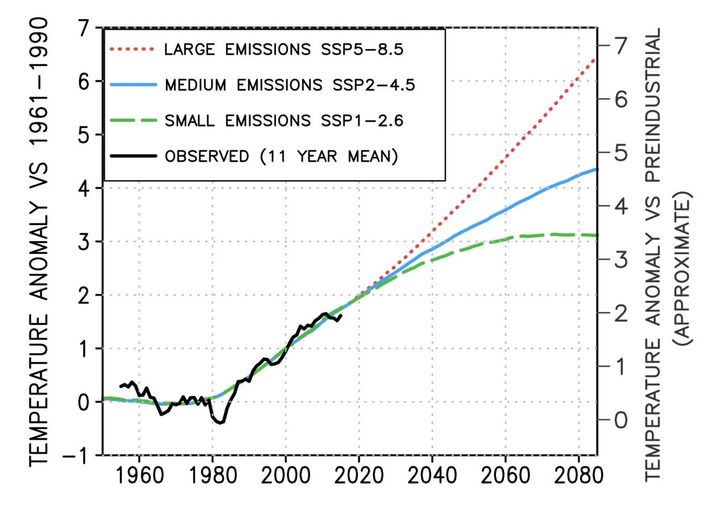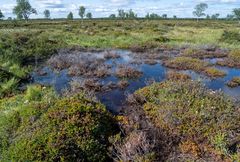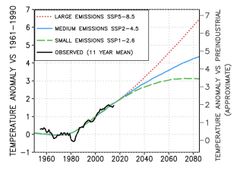Changes in the natural environment of the north will be rapid and partly irreversible
With the climate measures already decided, Lapland will grow up to 2–3 degrees warmer than today over the next 50 years, or 4–5 degrees compared to pre-industrial levels. This is revealed by a temperature analysis focused on Northern Norway and Swedish and Finnish Lapland.

The rising temperature will have a significant impact on the environment and livelihoods in the area. Biotopes will change and disappear as, for example, palsa mires and permafrost melt and mountain birch forests in many places die and turn into secondary mountain heaths and pine forests. The Arctic landscape will turn greener as open areas become overgrown with scrub and grasses. Animal species of the north will become endangered, and some may be lost. Almost 40 per cent of the open fell species are already threatened.
Increasing turbidity and eutrophication in waters and the spread of alien species, including the pink salmon, hogweeds and the fox into this area will make things worse for many species. Winters in Lapland will arrive later and be milder, which will affect negatively many livelihoods, including reindeer herding, nature tourism and construction.
All this is expected to happen over the lifetime of a person.
Temperatures to rise by 4–5 degrees with current climate actions
The Finnish Environment Institute coordinated the work on an analysis that produced information about climate warming in Fell Lapland. This area is already approx. two degrees warmer than in pre-industrial times. Even if most countries achieved their emissions reduction targets under the Paris Agreement reasonably well, the temperature in Fell Lapland will continue to increase by another 2 or 3 degrees over the next 50 years. This prediction is based on a situation where countries fulfil their current emissions reduction commitments without bringing in more stringent targets.
If nothing is done to control the increase in greenhouse gas emissions, at worst the temperature in Lapland may go up by 7 degrees compared to pre-industrial levels. The rise in temperature could be limited to 3 to 4 degrees, however, if all countries introduced new, strict and comprehensive restrictions in energy production, transport, construction, food production and consumption.

The Finnish Meteorological Institute, Metsähallitus Parks&Wildlife and Umeå University as well as a number of Nordic research and expert institutions and universities participated in producing the analysis.
Information on the impact of climate change at a single location
The analysis was produced for the virtual photographic exhibition Through the eyes of the gyrfalcon. This exhibition gathers for the first time together comprehensive information about the impact of climate change in Northern Norway and Finnish and Swedish Lapland. The exhibition combines impressive photographic art with a scientific knowledge base. It shows how climate change will affect the natural environment, livelihoods and local people’s lives in the north. The exhibition can be used as teaching material and for other similar purposes.
The physical version of the exhibition will tour Finland, Sweden and Norway in 2023–2026. In Finland, the first venue will be Taitokortteli crafts centre in Joensuu, where the opening of the exhibition will take place on 20 October 2023.
Keywords
Contacts
Riku LumiaroSenior SpecialistFinnish Environment Institute
Biodiversity, the exhibition
Kimmo RuosteenojaResearcherFinnish Meteorological Institute
Climate change
Media service at Finnish Environment Institute
Our Media Service provides information on research, helps journalists find experts for interviews and provides photos for media use.
Our Communication experts will answer your inquiries on weekdays from 9 am to 4 pm.
Images


Links
It is time to move beyond solving environmental problems one by one, to systemic sustainability transformations. The Finnish Environment Institute (Syke) contributes to building a sustainable society through research, information and services. The Finnish Environment Institute is a research institute with 700 experts and researchers located in Helsinki, Oulu, Jyväskylä and Joensuu.
Subscribe to releases from Suomen ympäristökeskus
Subscribe to all the latest releases from Suomen ympäristökeskus by registering your e-mail address below. You can unsubscribe at any time.
Latest releases from Suomen ympäristökeskus
Nuoret vaativat merkittäviä muutoksia ruuan kulutukseen ja tuotantoon16.12.2025 12:00:00 EET | Tiedote
Nuorten ruokaraati vaatii avointa ja tutkittua tietoa ruuasta – sen alkuperästä, tuotantotavoista ja vaikutuksista ilmastoon, luontoon ja hyvinvointiin. Ilman selkeitä faktoja vastuulliset kulutusvalinnat eivät ole mahdollisia. Nuoret luovuttavat kannanottonsa kansalliseen ruokastrategiaan 2040 maa- ja metsätalousministeriön tilaisuudessa 16.12.2025.
Kommunernas utsläpp fortsätter minska – trafikens andel av utsläppen ökar16.12.2025 06:00:00 EET | Pressmeddelande
Enligt förhandsberäkningsuppgifterna för 2024 minskade Finlands växthusgasutsläpp enligt Hinku-beräkningsreglerna med cirka fem procent jämfört med föregående år. På lång sikt har utsläppen sedan år 2005 minskat med 40 procent och jämfört med år 1990 med 43 procent.
Kuntien päästöt laskevat edelleen – liikenteen osuus päästöistä kasvaa16.12.2025 06:00:00 EET | Tiedote
Vuoden 2024 ennakkolaskentatietojen perusteella Hinku-laskentasääntöjen mukaiset Suomen kasvihuonekaasupäästöt laskivat noin viisi prosenttia edelliseen vuoteen verrattuna. Pitkällä aikavälillä vuodesta 2005 lähtien päästöt ovat vähentyneet 40 prosenttia ja vuoteen 1990 verrattuna 43 prosenttia.
Viikkokatsaus 15.–19.12.202511.12.2025 12:59:58 EET | Tiedote
Hei! Tässä tiedoksesi meillä Suomen ympäristökeskuksessa ensi viikolla ilmestyviä tiedotteita, uutisia, kampanjoita, blogeja ja uutiskirjeitä. Mukana myös tulevia tapahtumia ja webinaareja. Jakelemme viikkokatsauksen torstaisin STT:n kautta. Koosteet löytyvät myös STT-uutishuoneesta, josta voit tilata kaikki Suomen ympäristökeskuksen tiedotteet.
Viikkokatsaus 8.–12.12.20254.12.2025 12:30:18 EET | Tiedote
Hei! Tässä tiedoksesi meillä Suomen ympäristökeskuksessa ensi viikolla ilmestyviä tiedotteita, uutisia, kampanjoita, blogeja ja uutiskirjeitä. Mukana myös tulevia tapahtumia ja webinaareja. Jakelemme viikkokatsauksen torstaisin STT:n kautta. Koosteet löytyvät myös STT-uutishuoneesta, josta voit tilata kaikki Suomen ympäristökeskuksen tiedotteet.
In our pressroom you can read all our latest releases, find our press contacts, images, documents and other relevant information about us.
Visit our pressroom